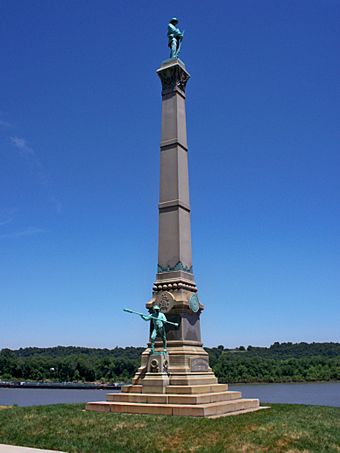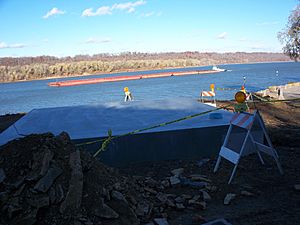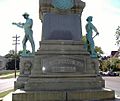Confederate Monument in Louisville facts for kids
Quick facts for kids |
|
|
Confederate Monument in Louisville
|
|

Monument in Brandenburg, June 2017. Ohio River in background.
|
|
| Lua error in Module:Location_map at line 420: attempt to index field 'wikibase' (a nil value). | |
| Location | Riverfront Park, Brandenburg, Kentucky |
|---|---|
| Built | 1895 |
| Architect | Ferdinand von Miller II |
| MPS | Civil War Monuments of Kentucky MPS |
| NRHP reference No. | 97000689 |
| Added to NRHP | July 17, 1997 |
The Confederate Monument in Louisville is a tall stone and bronze statue that used to stand near the University of Louisville in Louisville, Kentucky. It is 70 feet (about 21 meters) high. In late 2016, the monument was moved to Brandenburg, Kentucky, a town along the Ohio River.
This monument was built in 1895 by the Muldoon Monument Company. Money for it was raised by a group called the Kentucky Woman's Confederate Monument Association. The monument was created to honor soldiers from the Confederate side who died during the American Civil War.
Over the years, some people in Louisville, like Reverend Louis Coleman, felt the monument should be moved. They believed it was connected to a history of unfair treatment against African-Americans. For a long time, the city and university did not agree to move it. In 2002, the university planned to add other monuments nearby to create "Freedom Park." This park would also tell the story of civil rights.
In April 2016, Louisville officials decided to move the monument. A judge stopped the move for a short time, but then allowed it to go forward in May 2016. On November 15, 2016, the Mayor's office announced the monument would be taken apart and moved to Brandenburg. The town of Brandenburg held a special ceremony in May 2017 after the monument was put back together.
Contents
History of the Monument
How the Idea Started
The idea for the monument began in May 1887. People were talking about decorating graves at Cave Hill Cemetery. Soon after, a group called the Kentucky Woman's Confederate Monument Association was formed. They wanted to build a monument to Confederate soldiers in Louisville.
Michael Muldoon, from a monument company, suggested using only granite and bronze. He said these materials would last a long time. Nelly Marshall McAfee, a writer, also supported the idea. She offered to help organize groups across Kentucky to raise money.
The association grew from 17 members to over 250. Susan Marshall Preston Hepburn led the group. Many members were from Louisville, but women from all over Kentucky helped too. For example, over 40 women in Henderson joined the effort. One of them was Mary Towles Sasseen, who helped start Mother's Day.
Raising Money and Building It
At first, there was a plan for a marble arch over 3rd Street. It would honor "Unknown Confederate Dead." But a money crisis in 1893 slowed down fundraising.
People held many events to raise money. These included a performance of "Ben Hur" with over 100 people in 1891. They also had a "Toy Symphony" show in 1890 and boat trips on the Columbia riverboat. After years of picnics, auctions, dances, and other events, the monument was finished in summer 1895. It cost $12,000. The association even held fundraisers after the dedication to pay off the last debts. A talk by Henry Watterson, an editor, raised over $700 in November 1895.
After the monument was built, the women of the association joined the United Daughters of the Confederacy. By 1900, they had raised money for a stone fence and lamps around the monument.
Dedication Ceremony
The monument's first stone was placed on May 25, 1895. Inside, in a copper box, were historical items. These included newspapers, poems, photos, Confederate money, a Bible, and a cigar from Jefferson Davis.
The monument was officially dedicated on July 30, 1895. This was just before a big meeting of the Grand Army of the Republic (a group of Union veterans). The ceremony started with a parade. About 200 former Confederate soldiers marched to the monument. The only Confederate flag seen was a battle-worn one from the war.
Louisville's Mayor, Henry S. Tyler, accepted the monument for the city. Basil W. Duke gave a speech to a large crowd. He spoke about how important it is for people to remember their patriotic dead.
Similar Monuments and Key People
The same sculptor, Ferdinand Freiherr von Miller II from Germany, designed a similar monument in Raleigh, North Carolina, in 1895. Using the same design helped lower the cost of the Louisville monument.
One of the figures on both monuments was modeled after Judge Reginald H Thompson of Louisville. Judge Thompson was a Confederate veteran and a leader in the community. He helped start the Kentucky Children's Home and a school for newsboys. He also worked with the Industrial School of Reform, which was across the street from the monument.
People remembered Judge Thompson as a brave soldier. At his funeral in 1899, many people, including children from orphanages, lined the streets to honor him. The Courier-Journal newspaper described the top figure on the monument as having "an expression of unutterable sadness." One veteran said, "He looks like the 'Lost Cause'."
Efforts to Move It (1900s)
In the 1920s and 1940s, there were ideas to move the monument to a nearby park. This was to help with traffic jams and accidents. But people and city leaders wanted it to stay. In 1921, Mayor George Weissinger Smith and the United Daughters of the Confederacy stopped a plan to move it.
Later, Mayor Charles P. Farnsley, who fought for civil rights, even stood guard in front of the monument with a musket. He wanted to keep it where it was. In 1954, Mayor Andrew Broaddus tried again to move the monument as part of a big traffic project. By 1956, the city agreed to make the area around the monument smaller instead of moving it. This work was finished in 1957.
Freedom Park Project
The land near the monument was once a cemetery, then an orphanage and reform school. The University of Louisville bought the property in 1923.
In 2002, plans were made to include the monument in a larger "Freedom Park." The idea was to plant trees from Civil War battlefields there. A nearby street, once called Confederate Place, was renamed Unity Place.
In 2005, community activist Rev. Louis Coleman asked Mayor Jerry Abramson to remove the monument. In 2008, money was approved for Freedom Park. A sculptor named Ed Hamilton was chosen to create a civil rights monument to balance the Confederate Monument.
In 2002, J. Blaine Hudson, a professor at the University of Louisville, explained the park's goal. He said they wanted to show all the history of the Civil War and the time before it. In September 2015, the park was renamed Charles H. Parrish Jr. Freedom Park. This honored Dr. Parrish, the university's first African-American educator. Today, the park has black granite markers that tell Louisville's history and honor civil rights leaders.
Moving to Brandenburg, Kentucky
On November 15, 2016, Mayor Fischer announced the monument would move to Brandenburg. This town is 44 miles west of Louisville, along the Ohio River. The monument was taken apart starting November 19, 2016. A time capsule was found inside, but it was not in good condition.
Moving the monument cost about $400,000. The University of Louisville Foundation paid most of it. The city of Louisville and Brandenburg also helped. The work was finished on December 12, 2016. A new dedication ceremony was held on May 29, 2017, with about 400 people attending.
The monument's new home is in Riverfront Park in Brandenburg. East of the monument is a historical marker. It tells about Gen John Hunt Morgan and his men crossing into Indiana in 1863. This marker is part of a historical walking trail along the Ohio River. The trail also has figures honoring Native American history and the Underground Railroad. The park also hosts a Civil War reenactment of Morgan's Raid every two years.
Meade County, where Brandenburg is, was also a place where soldiers joined the Confederate army. These men became part of Nathan Bedford Forrest's cavalry.
Historic Status
The Confederate monument was added to the National Register of Historic Places on July 17, 1997. This list recognizes important historical sites. It was one of 61 Civil War sites in Kentucky added that day. Other monuments in Louisville also on the list include the 32nd Indiana Monument and the Union Monument in Louisville.
What the Monument Looks Like
The Louisville Confederate Monument is 70 feet tall. This makes it the second largest in Kentucky. It is made of granite and has three bronze Confederate soldiers. These soldiers were designed by the sculptor Ferdinand Freiherr von Miller II.
The soldier at the very top is an infantryman, about 95 inches tall. He holds a rifle and looks thoughtful. The two figures near the bottom are 70 inches tall. One is an artillerist holding a ramrod, and the other is a cavalryman with a sword.
On the north side of the monument, it says: "Our Confederate Dead, 1861–1865." On the south side, it says: "Tribute to the Rank and File of the Armies of the South." There is also a bronze medallion of the Seal of the Confederate States. The monument weighs about 140,000 pounds.
In the early 1900s, the monument had a large base with a diameter of 48 feet. There were also four fancy lamps around it, part of a stone fence. These lamps were designed by Louisville sculptor Enid Yandell. But by 1921, cars had damaged the fence and lamps. Both the fence and lamps were removed in 1957 to help with traffic.
In 1991, a study estimated that repairs to the monument would cost between $20,000 and $50,000. This included fixing parts of the bronze that were wearing out.
Bessie Laub, an art critic, wrote in 1917 that while other monuments might be more fancy, none showed more respect and feeling than the Louisville Confederate monument. The Muldoon Monument Company, which built it, used the monument in their advertisements. The company is still in business today.
Images for kids









